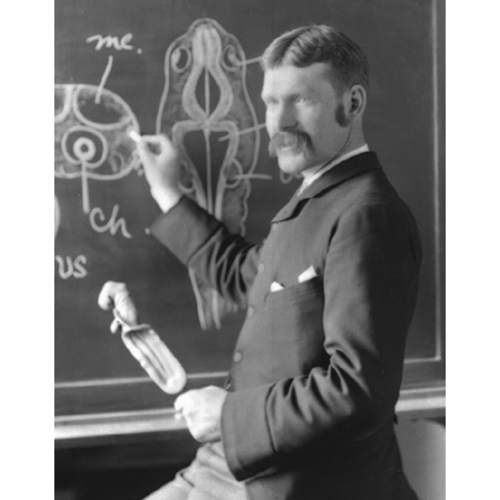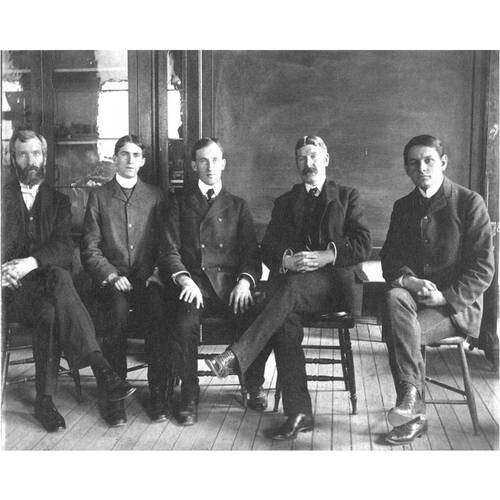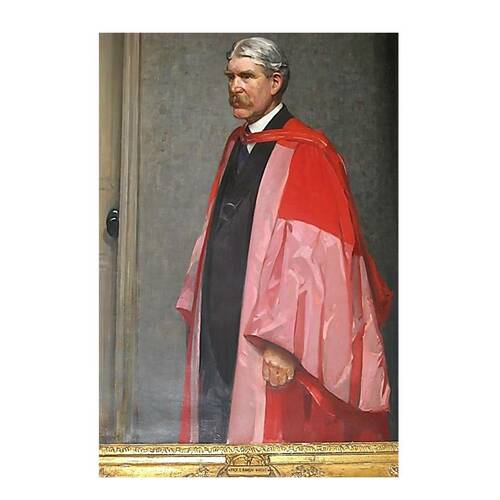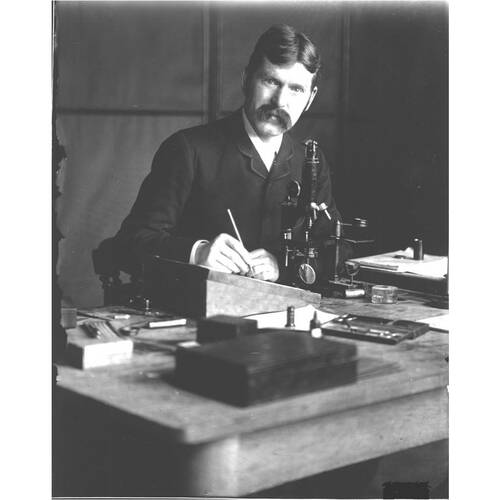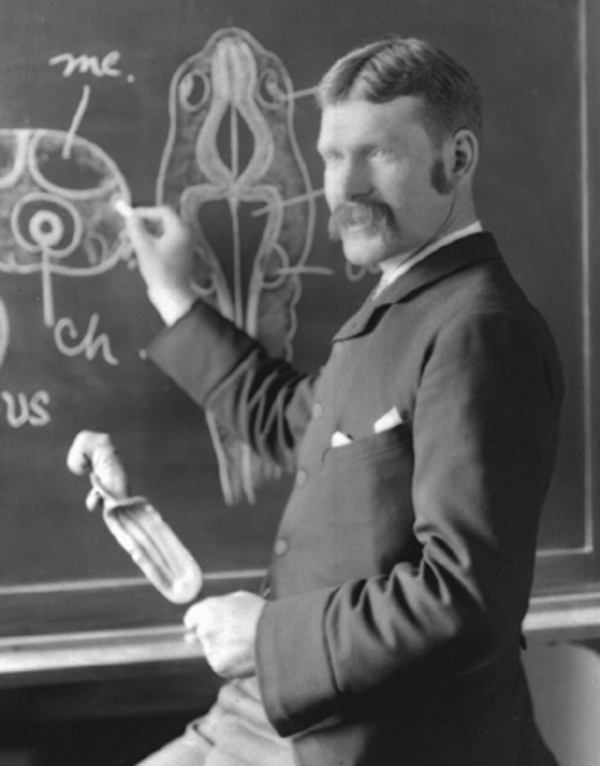
Source: Courtesy of Wikimedia Commons
WRIGHT, ROBERT RAMSAY, zoologist, university professor and administrator, and author; b. 23 Sept. 1852 in Alloa, Scotland, third and youngest son of the Reverend John Wright and Christian Ramsay; m. 22 June 1876 Katharine Octavia Smith (d. 5 July 1930) in Cockpen, Scotland; they had no children; d. 5 Sept. 1933 in Droitwich Spa, England.
Robert Wright, as he was known in Scotland, grew up in the town of Alloa, in the coalmining county of Clackmannanshire. His father had joined the Free Church of Scotland when it seceded from the Church of Scotland in 1843, and he served as minister of Alloa’s East Free Church, which shared the denomination’s extreme poverty. Closely associated with the coalfields was a significant fossil deposit that included what the pre-eminent scientist Thomas Henry Huxley in 1862 described as “a large Labyrinthodont, with well-ossified vertebrae.” The discovery of this deposit may have ignited young Robert’s interest in evolution.
Wright’s parents evidently shared the Scottish belief in the social and spiritual value of education. Perhaps assisted by his maternal uncle, John Ramsay, a prosperous distiller, Robert attended Alloa Academy and then Edinburgh’s Royal High School for matriculation into the University of Edinburgh. He enrolled there in the autumn of 1868, registering in the standard arts course, which led to a master’s as a first degree. The curriculum, which had not significantly changed since 1708, reflected the medieval trivium and quadrivium of compulsory Latin, Greek, and mathematics in the first two years and logic, moral philosophy, natural philosophy, and rhetoric (the last now including English literature) in the remaining sessions. The biological sciences were not offered to arts candidates, and his choice indicates that Wright had arrived to study the classics and humanities; those wishing to major in natural history would enrol in undergraduate medicine.
Having earned his ma in 1871, Wright proceeded to a degree in science. His pivotal change of course may have been inspired by a Sunday evening address delivered by Huxley in November 1868, entitled “On the physical basis of life.” The visiting scientist was renowned as a riveting speaker and a clear and fearless exponent of evolutionary principles. In the science program Wright’s courses included natural history with the esteemed biologist Charles Wyville Thomson and botany under the distinguished botanist and medical dean John Hutton Balfour, together with chemistry, physiology, and geology. The university’s records note that Wright’s bsc was awarded in 1873, without mention of scholarships or other awards. They also document his appointment that year as a laboratory instructor with the rank of assistant to Julius Viktor Carus of Leipzig, Germany, who substituted for Thomson while the latter directed the Challenger oceanography expedition in the years 1872–76. (Wright is not named in the chronicles of that international triumph of marine biology, and he himself never claimed affiliation with it, although assertions of his involvement were later made on his behalf.) In a letter to his uncle John in February 1874, he requested a loan to purchase a microscope so that he could prepare himself to “preside over a practical class and to demonstrate microscopic forms.”
Young Robert Wright was evidently a complete unknown in Canada when he successfully applied that year for the chair in natural history at University College, Toronto, to succeed Henry Alleyne Nicholson, and he was arguably among the least qualified of the seven candidates considered. Nevertheless, he had two attributes that would have struck a chord with the alumni who now dominated the University of Toronto’s senate following its reform in 1873. (While recommendations for the appointment would have come from the university, it was actually made by the Ontario premier, Oliver Mowat*.) First, Wright was the only candidate who was entirely educated after the publication of Charles Darwin’s On the origin of species … (London, 1859) at a prominent university that had absorbed the theory of evolution and trained its students in experimental research in the laboratory. Secondly, he was untarnished by association with known anti-Darwinians in Canada, such as McGill College’s John William Dawson*, or with sectarian institutions such as Queen’s College in Kingston. Unlike the more experienced George Lawson* at Dalhousie University and Robert Bell* of the Geological Survey of Canada, Wright was devoid of baggage from the country’s turbulent university politics.
In Canada, where he preferred his middle name, Ramsay, he seemed determined to present himself as an English gentleman of style. His assumed Oxford accent, combined with his taste for classicism and the arts of the salon, was a matter of almost universal remark by contemporaries, and he was routinely regarded by many colleagues as English in origin. During his early years in Toronto, Wright resided at the fashionable Queen’s Hotel on Front Street, while dazzling the city’s smartest drawing rooms with his musical gifts (he played the piano and the violin and sang) and his flair for classical poetry. He and his wife, Katharine, whom he returned to Scotland to marry in 1876, would live in a succession of handsome houses, first on St George Street and then on Spadina Avenue and Lonsdale Road. Apparently further distancing himself from his family background, he avoided any religious affiliation.
Wright’s supervisor at Edinburgh, Thomson, was an inspiration for the younger man’s lecturing style as well as his focus on marine biology. A “delightful and instructive lecturer, who had on his table a profusion of specimens of which he made incessant use,” Thomson spoke without notes. He was much admired by his students and attracted some of the largest classes at the university. Wright similarly had a wide following among students in Toronto. Initially he taught in makeshift laboratories at University College with only a few microscopes. But in 1878 a home for the School of Practical Science, not yet formally affiliated with the University of Toronto, was completed on the campus. Its laboratories were intended for professors and students in the physical sciences at both the college and the engineering school. The SPS would serve as Wright’s teaching and research base for the next 11 years, until a biological building was opened in 1889. In a move away from the blackboard instruction that had characterized teaching before the 1870s, a “practical acquaintance with the work” was demanded of honours students in the natural sciences from 1877 on, a change led by professor of mathematics and physics James Loudon*; by 1885 candidates for honours degrees in all scientific subjects were required to have certificates of laboratory work. Wright shared this orientation with his older colleague and his admiration for the German research ideal then coming into prominence.
In the 1880s he embarked on his most productive period of scientific research. He presented papers to the Canadian Institute, published in its journal, and served as the institute’s recording secretary in that decade; he would be its president from 1893 to 1895. Wright’s work ranged across parasitology, vertebrate morphology, and physiology; in the last discipline his examinations are exemplified by a series of studies with three former students, Archibald Byron Macallum, James Playfair McMurrich, and Thomas McKenzie, on the anatomy of Ameiurus catus (white, or Schuylkill, catfish), which were read before the Canadian Institute in 1884. He authored An introduction to zoology: for the use of high schools (Toronto, 1889), approved by the province of Ontario for its new course in zoology and widely used elsewhere in Canada. Given its emphasis on evolutionary principles, the influence of this work would have been significant. Wright also gave public and academic lectures on the emerging discoveries in germ theory led by Robert Koch in Germany and Louis Pasteur in France. Reflecting his interest in music and the classics was his contribution to an acclaimed production of Sophocles’s Antigone at University College in 1882, in which he adapted and directed the music of Mendelssohn for the choruses.
Invited to investigate the fish and fisheries of Ontario by the province’s game and fish commission, Wright prepared a preliminary report in 1892 that recommended the appointment of a permanent commission, a systematic survey of provincial waters, rigid inspection of the fisheries, and measures to counteract their decline. Together with other Canadian scientists, he promoted the establishment of the country’s first marine-biology station, launched on the east coast in 1899, in a structure that could be moved on a scow. Until his retirement from the University of Toronto in 1912, Wright was a member of the station’s board of management, later the Biological Board of Canada; he played an active role in its work, which was soon extended to the west coast and Georgian Bay in Ontario. He was also involved in such endeavours as the Toronto meeting of the British Association for the Advancement of Science in 1897, on whose local committee he served. Together with political economist James Mavor*, he edited the Handbook of Canada, prepared for the event.
Ramsay Wright held a number of posts at the University of Toronto. As well as teaching at University College and the School of Practical Science, he served as the first secretary of the SPS. Following the federation of Victoria University with the University of Toronto in 1887 [see Nathanael Burwash*], Wright’s position at University College changed to become that of university professor of biology in the federated institution. When the faculty of medicine was re-established at the same time, after a 34‑year hiatus, he was cross-appointed to biology and physiology. He would serve under deans William Thomas Aikins*, Uzziel Ogden*, Richard Andrew Reeve, and Charles Kirk Clarke* and see the opening of the medical building in 1903. Wright also became dean of the faculty of arts in 1901. Later that year he was asked by the provincial government to fill in for President Loudon during an illness and made vice-president. He would hold these various offices until his retirement.
In his high-school textbook, Wright acknowledged the importance of British evolutionary theorists Charles Darwin and Alfred Russel Wallace, but it was McMurrich, in an obituary of Wright, who noted that his late mentor had been influenced by T. H. Huxley and British evolutionist Henry Newell Martin. Huxley had championed reforms in medical education that emphasized a thorough grounding in the basic sciences as the foundation for clinical studies, and Wright strongly promoted such changes in Toronto. With Martin, who taught at Johns Hopkins University in Baltimore, Md, from 1876 and was an advocate of Huxley’s ideas, Wright and professor of medicine James Elliot Graham* developed a rapport that resulted in Toronto biology, physiology, and medical students continuing into postgraduate work at Johns Hopkins and specialist residencies at its hospital.
Wright had first met physician and medical educator William Osler* in 1874 when the latter, then a lecturer at McGill, was visiting Toronto at Christmas and introduced himself to the new professor. He became a friend and inspiration to Wright and a welcome speaker at ribbon cuttings for the university’s biological and medical buildings and at academic and professional conferences. In the summer of 1890 he and Wright visited universities and other scientific institutions in Europe. Wright was being sponsored by Vice-Chancellor William Mulock* to study natural-history museums for ideas that might inform the rebuilding of the University of Toronto’s collection, damaged in the fire that had gutted University College in February that year. In August they attended the 10th International Medical Congress in Berlin, where Koch, already renowned as the discoverer of the tubercule bacillus in 1882, famously announced a remedy for tuberculosis.
For Wright this news led to a second journey to Germany later in 1890, which Mulock again personally financed. Wright was to secure a reproducible sample of and the formula for “Koch’s lymph” (later called tuberculin, a test rather than a cure) for the University of Toronto. In November he was given a “rousing send-off” at the railway station by a large crowd of students. He obtained a consignment of the lymph and forwarded it to Macallum, now head of the new department of physiology. For victims of the disease, however, the failure of this supposed cure would prove especially tragic.
To the disgust of Loudon and President Sir Daniel Wilson*, Wright sided with Mulock in two controversies that preoccupied the university in the late 1880s and early 1890s. He was implicated in the contested deployment of rooms in the biological building for human dissections. When the issue was raised in both the university senate and the provincial legislature, it was revealed that such use had been added to plans for the new “museum wing” but had been kept secret by university officials for fear of antagonizing residents in nearby Queen’s Park. In a letter to the senate Mulock defended Wright from “any suspicion of unfair dealing” in the matter, saying that Wright had acted at his request. The other issue concerned plans for the Park Hospital, in which Wright was involved at the initial stages. It was to be built on university land with money donated by Toronto businessman and senator John Macdonald*, a project promoted by Mulock that collapsed after Macdonald’s will was declared invalid.
After Mulock resigned as vice-chancellor in 1900, Wright had no influential champion within the university administration. He had hoped to succeed Loudon as president when the latter left office in 1906, but he did little from his vice-presidential position to advance his candidacy. Despite securing a strong recommendation from University College principal Maurice Hutton, who claimed that Wright had the support of the senior staff, and a more muted one from Osler, he was passed over, to his evident “bitter disappointment.” However, the successful candidate, Robert Alexander Falconer*, sought him out to secure his allegiance, and the two men developed a close friendship that would continue after Wright’s retirement.
In his last years in Canada Wright publicly supported the increasingly popular but later discredited eugenics movement, which had originated with British geneticist Sir Francis Galton. By 1911 he had come to believe that the concepts which lay behind this movement, championed locally by medical dean C. K. Clarke, represented one of the “new sciences” emerging from biology. In his presidential address to the Royal Society of Canada that year, Wright told the country’s intellectual elite that “some of the causes of decadence may undoubtedly be counteracted by the judicious application of sound eugenic principles, and any nation will do well to give these serious consideration.” Shortly after, he went public with his promotion of these ideas. On a July evening the same year, at a lecture on Galton that drew a capacity crowd to the university’s new physics auditorium, he delivered a direful message about “the polyglot population of immigrants,” criminal offenders, the mentally ill, and other “bad” strains of stock. Governments should assume various prescriptive duties, he said, including the regulation of marriage and restrictions on immigration. In July 1912, as a delegate from the University of Toronto, Wright attended the First International Eugenics Congress, held at the University of London; among the congress’s vice-presidents were Canadians Alexander Graham Bell* and Sir William Osler, though the latter had by then withdrawn from involvement in the event.
Ramsay Wright possessed undeniable skills as a classroom teacher, mentor, and public speaker. In the biological building he established a strong esprit de corps among both arts and medical students, and his emphasis on zoology influenced a generation of graduates who pursued careers in animal science. Many contemporaries praised him unreservedly, from Toronto’s undergraduates to a future prime minister, William Lyon Mackenzie King*. In 1901 King noted in his diary that Wright’s public lecture in Ottawa on malaria and mosquitoes was most interesting, “delivered exceedingly well, without notes, in a popular & yet cultured manner. I thought Wright did credit to the University & showed to firstrate advantage.” His charisma evidently suffused his activities with a glow sufficient to earn him decades of uncritical hero worship and myth-making in his adopted land. That his research activity and publications were limited has been explained by self-imposed heavy loads in teaching, mentoring, and administration during the later part of his career.
Wright received honorary degrees from the universities of Toronto (lld 1902), Edinburgh (lld 1912), and Oxford (ma 1914). In retirement he went to live in Oxford, where he renewed his friendship with Osler. After the physician’s death, Wright assisted with the cataloguing of the famous Osler library. His interest in linguistics also came to the fore; during World War I he translated documents in foreign languages for the British War Office. Later Wright and his wife travelled in Europe and North Africa while her health permitted. She died in 1930, and he followed three years later.
Through his friendship with President Falconer, the University of Toronto had commissioned an official portrait of Wright in 1918 from English artist John Alfred Arnesby Brown. His only documentary legacy was his bequest to the university library of the typescript of a retirement project, a translation from Persian of a work by a celebrated medieval astronomer. He also left his gowns and hoods to the university and one half (approximately $15,000) the cash residue of his estate to establish a scholarship in zoology; the other half was designated for a scholarship at the University of Edinburgh. In 1965 the University of Toronto named the new Ramsay Wright Zoological Laboratories in his honour.
The most complete list of Robert Ramsay Wright’s scientific publications is provided in S. F. McRae, “The ‘scientific spirit’ in medicine at the University of Toronto, 1880–1910” (phd thesis, Univ. of Toronto, 1987), 393–96. He also published articles in the Canadian Practitioner (Toronto), the Univ. of Toronto Monthly, and other journals. His “Preliminary report on the fish and fisheries of Ontario” to the Ont., Game and Fish Commission appeared in its Commissioners’ report (Toronto, 1892), 419–76. Wright’s presidential address to the RSC was published as “The progress of biology” in RSC, Trans., 3rd ser., 5 (1911), proc.: xxxvii–xlviii. His translation from a Persian manuscript of Muhammad ibn Ahmad al-Bīrūnī’s treatise on astronomy is held in Thomas Fisher Rare Book Library at the Univ. of Toronto. It appeared after Wright’s death as The book of instruction in the elements of the art of astrology (London, 1934) in a limited edition with English and a facsimile of an Arabic manuscript on facing pages.
AO, RG 2-29-1-252; RG 8-1-1. LAC, “Diaries of William Lyon Mackenzie King,” 30 March 1901: www.bac-lac.gc.ca/eng/discover/politics-government/prime-ministers/william-lyon-mackenzie-king/Pages/diaries-william-lyon-mackenzie-king.aspx (consulted 9 April 2014). NRS, OPR Births & Baptisms, Alloa (Clackmannan), 23 Sept. 1852; SR Marriages, Cockpen (Edinburgh), 22 June 1876. UTARMS, A1967-0007/RSIN 0002/A67-0007(055); A1973-0015/040; A1973-0026/528(48); B1965-0014/004; B1972-0031/016(11); B1978-0010/020(05); B2005-0006/022(29). Daily Mail and Empire, 19 July 1911. Evening Telegram (Toronto), 9 March 1934. Globe, 19 July 1911. Times (London), 7 Sept. 1933. P. A. Bator, with A. J. Rhodes, Within reach of everyone: a history of the University of Toronto School of Hygiene and the Connaught Laboratories (2v., Ottawa, 1990–95), 1. Michael Bliss, William Osler: a life in medicine (Toronto, 1999). Canadian men and women of the time (Morgan; 1912). J. P. M. Court, “Recruiting a scientific enigma: Ramsay Wright at the University of Toronto and its reconstituted medical school, 1874–1912,” Hist. Studies in Education (Toronto), 22 (2010), no.1: 61–81; “Introducing Darwinism to Toronto’s post-1887 reconstituted medical school,” Canadian Bull. of Medical Hist. (Waterloo, Ont.), 28 (2011): 191–212. E. H. Craigie, A history of the department of zoology of the University of Toronto up to 1962 ([Toronto, 1966]). Harvey Cushing, The life of Sir William Osler (2v., Oxford, Eng., 1925), 1. M. L. Friedland, The University of Toronto: a history (Toronto, 2002). R. D. Gidney and W. P. J. Millar, “The reorientation of medical education in late nineteenth-century Ontario: the proprietary medical schools and the founding of the faculty of medicine at the University of Toronto,” Journal of the Hist. of Medicine and Allied Sciences (New Haven, Conn.), 49 (1994): 52–78. J. G. Greenlee, Sir Robert Falconer: a biography (Toronto, 1988). A. G. Huntsman, “Robert Ramsay Wright,” RSC, Trans., 3rd. ser., 28 (1934), proc.: iv–vi. Kenneth Johnstone, The aquatic explorers: a history of the Fisheries Research Board of Canada (Toronto, 1977). W. J. Loudon, Sir William Mulock: a short biography (Toronto, 1932). J. P. McM[urrich], “Prof. R. Ramsay Wright,” Nature (London), 21 Oct. 1933: 631. The University of Toronto and its colleges, 1827–1906, ed. [W. J. Alexander] (Toronto, 1906). Univ. of Toronto Monthly, 34 (1933–34): 22, 165.
Cite This Article
John P. M. Court, “WRIGHT, ROBERT RAMSAY,” in Dictionary of Canadian Biography, vol. 16, University of Toronto/Université Laval, 2003–, accessed January 6, 2026, https://www.biographi.ca/en/bio/wright_robert_ramsay_16E.html.
The citation above shows the format for footnotes and endnotes according to the Chicago manual of style (16th edition). Information to be used in other citation formats:
| Permalink: | https://www.biographi.ca/en/bio/wright_robert_ramsay_16E.html |
| Author of Article: | John P. M. Court |
| Title of Article: | WRIGHT, ROBERT RAMSAY |
| Publication Name: | Dictionary of Canadian Biography, vol. 16 |
| Publisher: | University of Toronto/Université Laval |
| Year of publication: | 2015 |
| Year of revision: | 2015 |
| Access Date: | January 6, 2026 |


